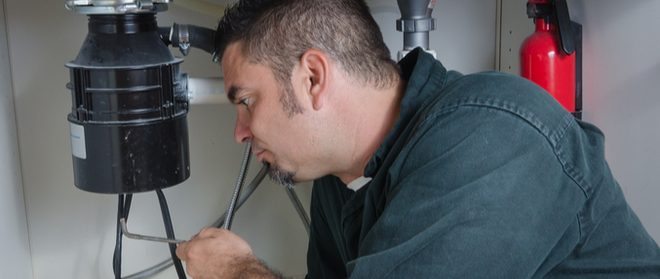Confirmed Solutions for Fixing a Dripping Garbage Disposal
Confirmed Solutions for Fixing a Dripping Garbage Disposal
Blog Article
Everyone has their unique idea about Garbage Disposal Leaking From Bottom.

Garbage disposals are vital kitchen area appliances that aid in getting rid of food waste successfully. Nevertheless, a leaking waste disposal unit can be an irritating and messy issue to take care of. Luckily, several leaks can be dealt with conveniently with a couple of easy actions. In this write-up, we will certainly talk about exactly how to take care of a leaking garbage disposal efficiently.
Introduction
Waste disposal unit are installed under cooking area sinks and are designed to shred food waste right into smaller items, enabling it to pass through the pipes system conveniently. While these gadgets are typically trustworthy, leakages can happen gradually due to damage, loosened links, or damages to the device.
Usual Causes of Leaks in Garbage Disposals
Worn Seals and Gaskets
Seals and gaskets play a critical duty in stopping water from dripping out of the waste disposal unit. With time, these elements can wear away, leading to leaks around the disposal device.
Loose Connections
The connections in between the garbage disposal and the plumbing system can become loosened in time, creating water to leakage out throughout procedure.
Cracks or Holes in the Disposal System
Physical damage to the garbage disposal, such as fractures or holes in the real estate, can additionally cause leaks.
Determining the Resource of the Leak
Before trying to take care of a leaking garbage disposal, it is vital to identify the resource of the leak. This can generally be done via aesthetic assessment or by performing easy tests.
Visual Evaluation
Evaluate the garbage disposal unit carefully for any kind of signs of water leakage. Pay attention to locations around seals, gaskets, and link factors.
Examining for Leakages
One means to test for leakages is by running water via the disposal system and checking for any type of visible signs of leak.
Tools and Materials Needed for Repairing a Leaking Garbage Disposal
Prior to starting the fixing procedure, gather the needed tools and products, including a screwdriver, flexible wrench, plumbing professional's putty, replacement seals or gaskets, and epoxy or patching product for repairing splits or openings.
Step-by-Step Overview to Taking Care Of a Dripping Garbage Disposal
Shut off the Power
Before attempting any type of repair work, ensure that the power to the garbage disposal unit is turned off to avoid the risk of electric shock.
Situate the Leakage
Recognize the specific area of the leakage and establish the cause.
Tighten up Links
Use a wrench to tighten any loose connections in between the disposal device and the pipes system.
Replace Seals or Gaskets
If the leak results from worn seals or gaskets, get rid of the old elements and replace them with brand-new ones.
Patching Cracks or Holes
For fractures or holes in the disposal unit, use epoxy or an appropriate patching material to seal the broken location.
Testing the Waste Disposal Unit After Fixing
As soon as the repair service is complete, examine the garbage disposal by running water via it to make certain that the leak has been dealt with.
Preventive Upkeep Tips to Stay Clear Of Future Leaks
To prevent future leaks, it is essential to execute regular upkeep on your garbage disposal. This consists of maintaining it clean, avoiding putting non-food items or tough things down the disposal, and regularly checking for leaks or other concerns.
Verdict
To conclude, dealing with a leaking waste disposal unit is a reasonably simple process that can be finished with fundamental tools and products. By following the actions detailed in this short article and practicing preventative maintenance, you can keep your waste disposal unit in good working condition and prevent pricey repair services in the future.
What to Do About a Leaking Garbage Disposal
A leaking garbage disposal often goes unnoticed until you confront a sopping cabinet, a foul-smelling puddle, or an audible drip-drip-drip from the unit. The fix can be frustrating, too, because the leak can stem from a number of components in the system. Fortunately, with a little sleuthing, you can zero in on the leak and—depending on the exact location—stop the icky oozing and repair the component that caused it. Worst case scenario, if it turns out that the garbage disposal must be replaced, installing a new one is a reasonable do-it-yourself task for those with basic plumbing skills. Read on to keep the cash you’d otherwise hand over to a pro.
Prepare to find the leak
Prior to testing the garbage disposal for leaks, unplug it at the wall outlet and turn off the power from the breaker box to prevent electrical shock. Then insert a watertight sink stopper into your sink drain and wipe the unit dry with a clean cloth. In any handy container, mix a few drops of food coloring into a few cups of water, and pour the dyed water onto the sink stopper to help you locate the leak.
Investigate the source
the top, where the disposal meets the sink drain the side, where the dishwasher hose or main drain pipe connects to the disposal or the bottom of the unit Inspect each of these locations while gliding a light-colored rag over the unit; the dyed water will readily show on the rag and reveal the location of the leak. If a leak isn’t immediately apparent, remove the sink stopper and pour a few more cups of dyed water down the sink drain, then check for leaks again. Leaks near the top of the unit are more likely to show themselves while the sink is plugged, while side and bottom leaks are more noticeable while the sink is unplugged.
The metal sink flange that sits directly inside the sink drain is typically sealed around the top with plumber’s putty (a clay-like sealant) and then secured from under the sink with bolts. If the plumber’s putty deteriorates, or the bolts loosen, the flange can no longer form a watertight seal between the sink drain and the disposal—which could cause a leak at the top of the unit.
To reseal the leaky flange, you must first detach the garbage disposal. Start by loosening the screws securing the main drain pipe to the disposal, then loosen the screws in the metal clamp securing the dishwasher hose to the disposal and detach the drain pipe and dishwasher hose from the disposal. Loosen the screws in the mounting ring that connects the disposal to the metal mounting assembly beneath the sink, then pull down the disposal and carefully set it on a clean, dry surface. Loosen the bolts in the mounting assembly with a wrench, then pull down the mounting assembly and set it near the disposal.

As a fervent reader about Why Is , I imagined sharing that excerpt was important. Do you know another person who is interested in How to fix a pretty consistent leak from my garbage disposal? Why not promote it. I value reading our article about The Handy Guide To Fixing Your Garbage Disposal Leaking.
Call Today Report this page